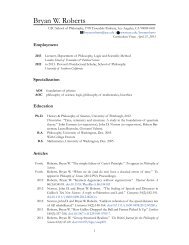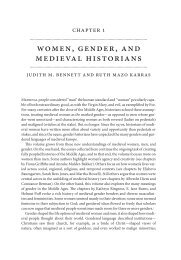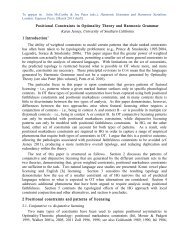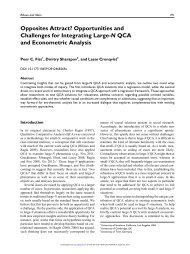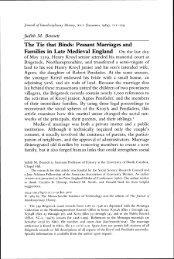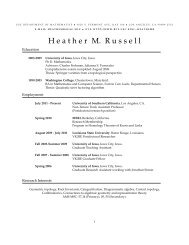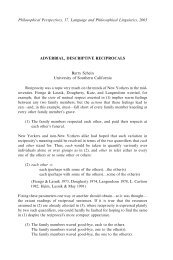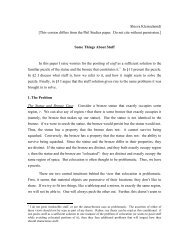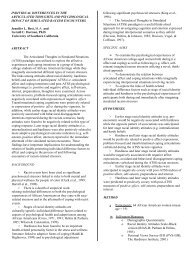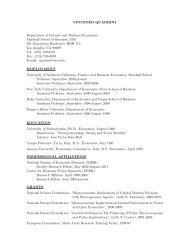The Diffusion of Ideas over Contested Terrain - Personal World Wide ...
The Diffusion of Ideas over Contested Terrain - Personal World Wide ...
The Diffusion of Ideas over Contested Terrain - Personal World Wide ...
You also want an ePaper? Increase the reach of your titles
YUMPU automatically turns print PDFs into web optimized ePapers that Google loves.
6<br />
An ordinal measure <strong>of</strong> ownership is<br />
preferable here because it recognizes the<br />
importance <strong>of</strong> control thresholds, but<br />
measuring block ownership using a percentage<br />
measure led to essentially identical<br />
results.<br />
#2144-ASQ V49 N4-December 2005—file: 49401-fiss<br />
terms <strong>of</strong> control agreements and supervisory board<br />
elections. 6 <strong>The</strong> ownership-level variable was coded for each<br />
owner group and was set to zero if that owner category controlled<br />
less than 5 percent <strong>of</strong> a firm’s voting share, 1 for control<br />
<strong>over</strong> at least 5 percent but less than 25 percent <strong>of</strong> voting<br />
shares, 2 for control <strong>over</strong> at least 25 percent but less than 50<br />
percent, 3 for control <strong>over</strong> at least 50 percent but less than<br />
75, and 4 for control <strong>over</strong> 75 percent or more <strong>of</strong> voting<br />
shares. For each ownership category, we further created two<br />
groups <strong>of</strong> owners (espousing vs. non-espousing, pro-business<br />
vs. pro-labor, 1st and 2nd vs. 3rd or later generation) to<br />
contrast differences in these groups and verify that effects<br />
are not merely due to ownership levels per se.<br />
Information about espousal <strong>of</strong> corporate owners came from<br />
our analysis <strong>of</strong> annual reports. For our measure <strong>of</strong> German<br />
federal and state g<strong>over</strong>nments as pro-business or pro-labor,<br />
we collected data on whether these g<strong>over</strong>nments were controlled<br />
by the German conservative or social-democratic party<br />
or party-led coalitions. To determine the effect <strong>of</strong> family ownership<br />
beyond the founder’s generation, we collected data on<br />
the firm’s age and categorized family holdings as being controlled<br />
by the founder or the founder’s generation if the firm’s<br />
age was less than 30 years. If the firm was more than 30<br />
years but less than 60 years old, we categorized family holdings<br />
as being controlled by the family’s second generation. If<br />
the firm was more than 60 years old, we categorized family<br />
holdings as controlled by the third or later generation.<br />
Information on the CEO’s age and educational background<br />
came from Leitende Münner und Frauen der deutschen<br />
Wirtschaft, a directory <strong>of</strong> German executives published by<br />
Hoppenstedt Verlag, various years. This source was supplemented<br />
by information from Bloomberg Pr<strong>of</strong>essional, Lexis-<br />
Nexis, ABI/Inform, and from the firms’ annual reports.<br />
Control Variables<br />
<strong>The</strong> financial economic view suggests that the growing internationalization<br />
<strong>of</strong> financial markets places increasing pressure<br />
on corporations to conform to Anglo-American g<strong>over</strong>nance<br />
principles (Useem, 1998; Bradley et al., 1999; C<strong>of</strong>fee, 1999;<br />
Hansmann and Kraakman, 2001). When competing in these<br />
financial markets, German companies may therefore come<br />
under pressure to conform to a shareholder value orientation.<br />
Because reliance on the stock market for financing may thus<br />
influence the propensity to espouse a shareholder value orientation,<br />
we controlled for it using the firm’s debt-to-equity<br />
ratio corrected for the share <strong>of</strong> equity held by outsiders. This<br />
measure is superior to an uncorrected ratio, such as total<br />
debt divided by common equity, because it only focuses on<br />
the amount <strong>of</strong> equity raised externally (cf. La Porta, Lopez-de-<br />
Silanes, and Shleifer, 1997). For example, if one single blockholder<br />
held 90 percent <strong>of</strong> a firm’s equity and only 10 percent<br />
<strong>of</strong> equity was dispersed, then using common equity <strong>of</strong> the<br />
whole firm would severely <strong>over</strong>state the amount <strong>of</strong> capital<br />
that was raised externally. Our corrected measure <strong>of</strong> external<br />
market capitalization was calculated as a firm’s market capitalization<br />
multiplied by its fraction <strong>of</strong> widely held shares. Following<br />
La Porta, Lopez-de-Silanes, and Shleifer (1997), we<br />
516/ASQ, December 2004



